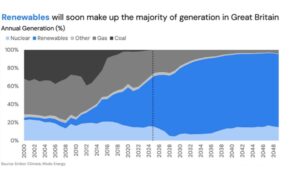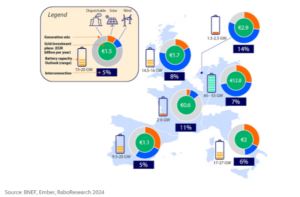Insights
The Key to the Energy Transition – BESS in UK and Continental Europe
Innovo is leading the transition to a sustainable future by harnessing the power of renewable energy through multi-technology solutions. There remains no doubt that Energy Storage and specifically BESS Lithium Ion (L-Ion) technology, is fundamental to that transition. Renewables will soon make up most generation in the UK and Europe, the graph below provides an illustration:

We see the same trend across Europe as the expected Renewables penetration increases.

There has, in the past, been a flawed argument against Renewables and in favour of Nuclear and even Thermal power due to the intermittency caused by Renewables.
But by stabilising the grid and by storing electricity at times of high generation for release later, BESS can help ensure renewables energy supply can be provided all day round.
As a general rule of thumb, for every 10MW of renewable energy, at least 1 to 2 megawatts (MW) of energy storage will be required. [Source – International Renewable Energy Agency – World Transitions Outlook 2024.]
And the existing global Battery Storage fleet provides some but not all the solution to the “problems” caused by intermittent Renewables on the grid; it doesn’t store energy at scale for more than 2-4 hour, yet.
For the first rush of investment into BESS, investors have been primarily driven by the economics available from being paid to provide “Ancillary Services” or “Frequency Response” (both these phrases effectively mean regulating the Frequency disturbances caused to the grid by highly variable Renewables.) This, together with Arbitrage of Electricity Price over short time periods, has provided a compelling business case for L-Ion BESS to date.
This brought the industry to a large enough scale to benefit from dramatic cost reductions and economies of scale. These will enable further innovation and lower cost longer duration storage in the future.
Governments, regulators and grid operators are now starting to intervene in what has been a historic economic investment bias towards short duration storage. This is being done through incentivisation for Longer Duration Energy Storage (LDES) to better meet the need for longer “time shifting” of excess renewable generation.
In the UK, a cap and floor mechanism are being developed for 6h+ duration storage, but controversially, this may exclude L-Ion BESS. In our view this is perverse, but DESNZ, the UK Government department for Energy and Net Zero state that “they wish to exclude technologies that can already be funded (i.e. exclude the most commercially viable technology).”
In Italy, L-Ion BESS can be economically rewarded for providing supply for 8 hours with the MACSE scheme.
In other countries, Capacity Markets favouring 4h+ BESS solutions are being developed or implemented.
The devil remains in the detail of whether the emerging market mechanisms will sufficiently support the required economics for project investment.
It is essential that Industry continues to engage and lobby key stakeholders to enable BESS deployment across short and long duration, and in turn enable the Energy Transition.
At Innovo we engage regularly directly with the stakeholders and industry groups in all our local offices and networks in Italy, UK and Spain. As part of this effort, we are happy to link up with other Industry members with a focus on BESS.
Why Lithium Ion BESS, not gas, hydro storage, or even Hydrogen?
L-Ion BESS is not the only form of Energy Storage. Hydro has historically provided solutions for energy storage (and some Frequency Response). And there is a lot of talk about Hydrogen and Gas combined with Carbon Capture and Storage (CCS) to provide a clean “Gas” solution to storage. But these solutions are far from fully developed or proven and may not be viable.
L-Ion BESS is currently the most reliable solution for grid stability, short- to medium-term energy storage, and renewable integration thanks to technological maturity, rapid deployment, operational flexibility, and alignment with decarbonisation. Why?
- L-Ion BESS batteries have been commercially proven with a large-scale development whereas hydrogen and CCS (which is required for clean gas) are still unproven, emerging and require significant upfront investment with uncertain future revenues.
- L-Ion BESS can be deployed quickly whereas hydropower requires specific geographic conditions which are (increasingly) scarce and have a long lead time for installation
- L-Ion BESS is more flexible in its applications (frequency response, balancing mechanism, wholesale trading etc…) providing a readily investable project
- L-Ion BESS has a lower operational cost and provides consistent performance without relying on external processes or fuel suppliers. Hydrogen storage, for example, depends on complex process such as electrolysis and compression introducing a higher operational risk
Which technologies could potentially complement Lithium-Ion batteries in the coming years?
Two notable alternative technologies are sodium ion batteries (Na-Ion) and Redox Flow Batteries (Vanadium redox batteries).
Sodium Ion batteries are less flammable (although there are now very robust fire safety measures in place for modern L-Ion solutions). They do not require critical raw materials, which could in theory make them cheaper. However, they also have lower efficiency and energy density, resulting in more expensive, bulky systems.
Redox flow batteries operate differently from lithium- and sodium-ion batteries as a system with two fully soluble redox couple solutions in each half-cell. This technology is more suitable for LDES. They are non-flammable and with high flexibility in term of capacity, however care is needed because some electrolytes are toxic.
As of today, these two technologies are commercially immature and not available for a large-scale distribution, but in the future they may work alongside lithium-ion batteries in the energy transition.
In summary, it is our view that UK and European Authorities often underestimate the continuing role of BESS, and in particular Lithium-Ion BESS technology in our journey to Net Zero, alongside the complementary emerging technologies. There is much more work to be done!
